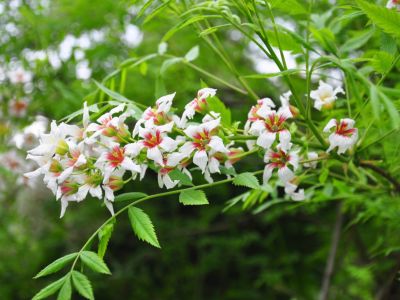What is a Yellowhorn Tree?
Yellowhorn trees (Xanthoceras sorbifolium) are deciduous shrubs to small trees (6-24 feet tall) that are native to north and northeast China and Korea. The foliage looks a bit like a sumac and is glossy dark green on the upper side and paler on the underside. Yellowhorns bloom in May or June prior to leafing out in sprays of white blossoms with greenish-yellow streaking with a blush of red at their base. The resulting fruit is round to pear shaped. These fruit capsules are green gradually maturing to black and sectioned off into four chambers inside. The fruit can be as large as a tennis ball and contains up to 12 shiny, black seeds. When the fruit ripens, it splits into three sections, revealing the spongy white interior pulp and the round, purplish seeds. For the tree to produce yellowhorn tree nuts, more than one yellowthorn tree is needed nearby to achieve pollination. So why are yellowthorn trees so much more than just rare specimens? The leaves, flowers and seeds are all edible. Apparently, the seeds are said to taste much akin to macadamia nuts with a slightly waxier texture.
Yellowthorn Tree Information
Yellowhorn trees have been cultivated since the 1820’s in Russia. They were named in 1833 by a German botanist by the name of Bunge. Where its Latin name is derived is somewhat debated – some sources say it comes from ‘sorbus,’ meaning ‘mountain ash’ and ‘folium’ or leaf. Another contends that the genus name comes from the Greek ‘xanthos,’ meaning yellow and ‘keras,’ meaning horn, due to the yellowish horn-like projecting glands between the petals. In either case, the genus Xanthoceras is derived of only one species, although yellowthorn trees may be found under many other names. Yellowthorn trees are also referred to as Yellow-horn, Shinyleaf yellow-horn, hyacinth shrub, popcorn shrub and northern macadamia due to the edible seeds. Yellowthorn trees were brought to France via China in 1866 where they became part of the collection of the Jardin des Plantes in Paris. Shortly thereafter, yellowthorn trees were brought to North America. Currently, yellowthorns are being cultivated for use as biofuel and with good reason. One source stated that yellowthorn tree fruit is comprised of 40% oil, and the seed alone is 72% oil!
Growing Yellowthorn Trees
Yellowthorns can be grown in USDA zones 4-7. They are propagated via seed or root cuttings, again with variable information. Some people say that the seed will germinate without any special treatment and other sources state that the seed needs at least 3 months cold stratification. The tree can also be propagated via division of suckers when the plant is dormant. It does sound like soaking the seed accelerates the process, however. Soak the seed for 24 hours and then nick the seed coat or use an emery board and shave the coat slightly until you see a suggestion of white, the embryo. Be careful not to shave too far down and damage the embryo. Re-soak for another 12 hours and then sow in moist, well-draining soil. Germination should occur within 4-7 days. However you propagate a yellowthorn, it does take quite a while to establish. Be aware that although there is scanty information, the tree likely has a large tap root. No doubt for this reason it does not do well in pots and should be transplanted into its permanent site as soon as possible. Plant yellowthorn trees in full sun to light shade in medium moisture soil (although once established, they will tolerate dry soil) with a pH of 5.5-8.5. A relatively unfussy specimen, yellowthorns are fairly hardy plants, although they should be protected from cold winds. Otherwise, once established, yellowthorns are fairly maintenance free trees with the exception of removing suckers on occasion.
